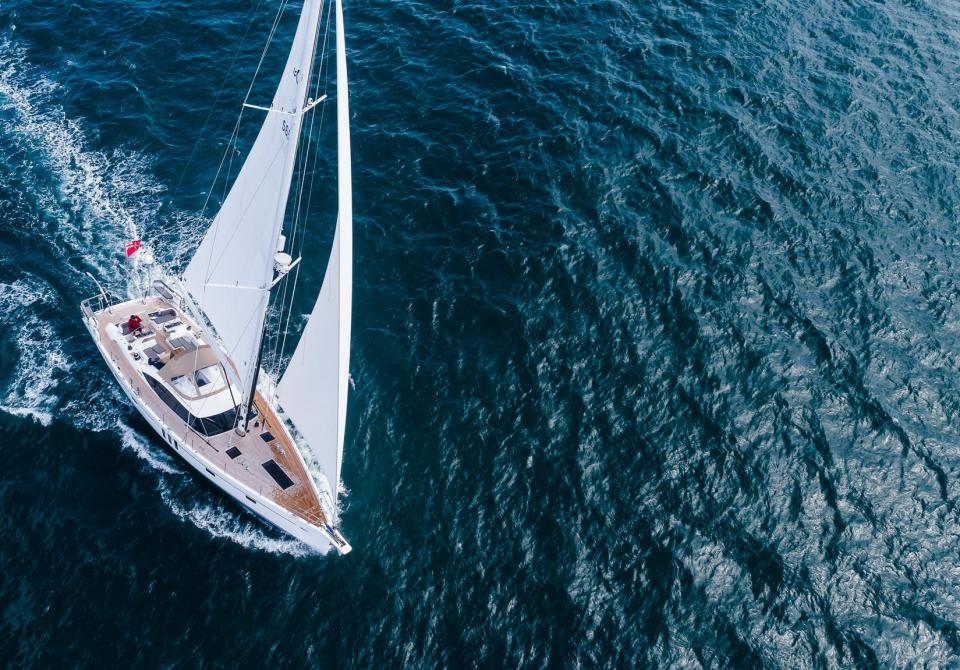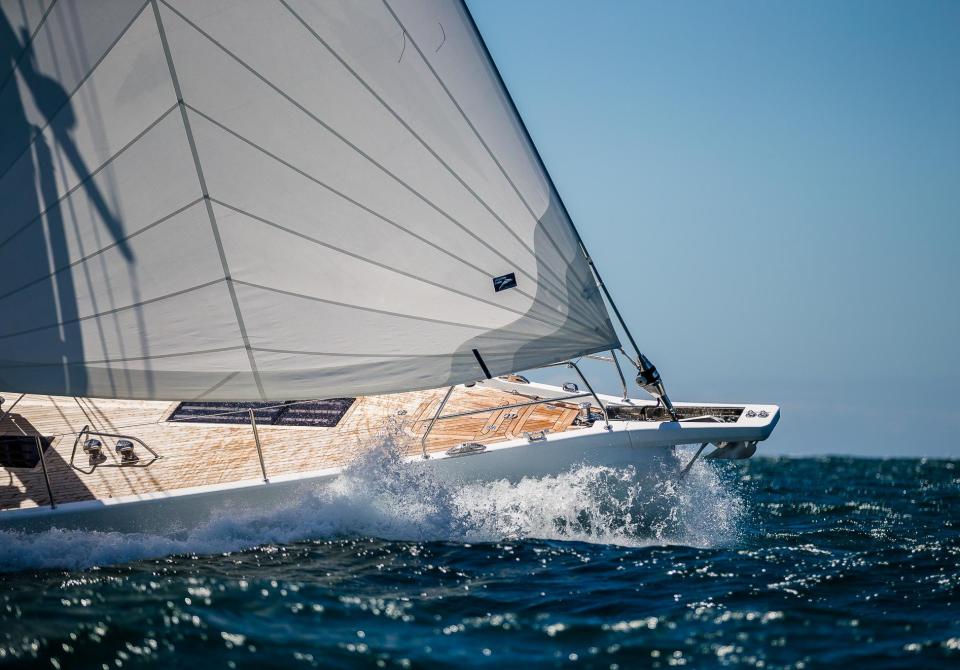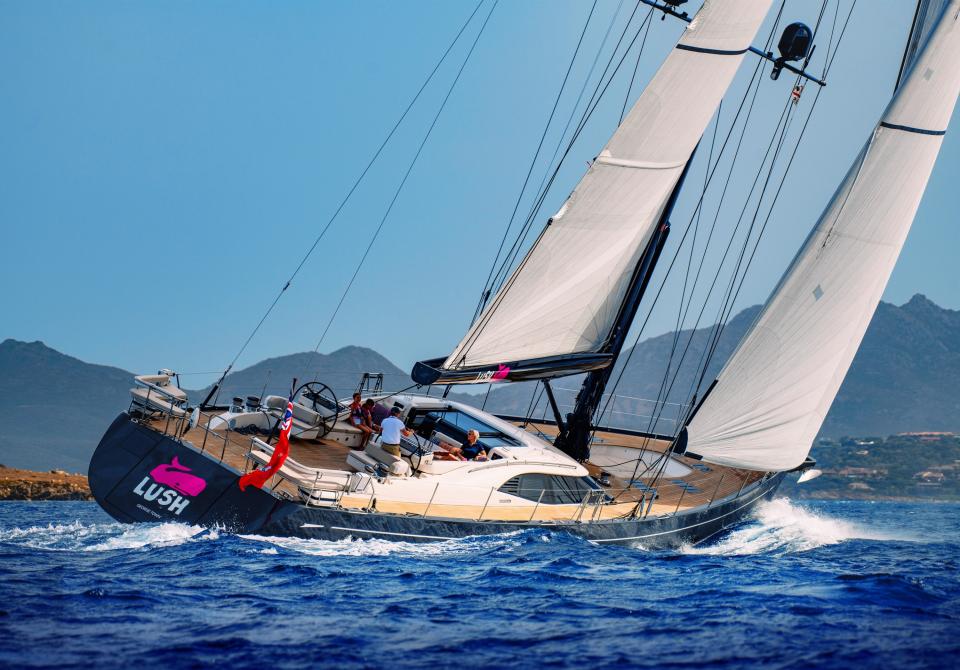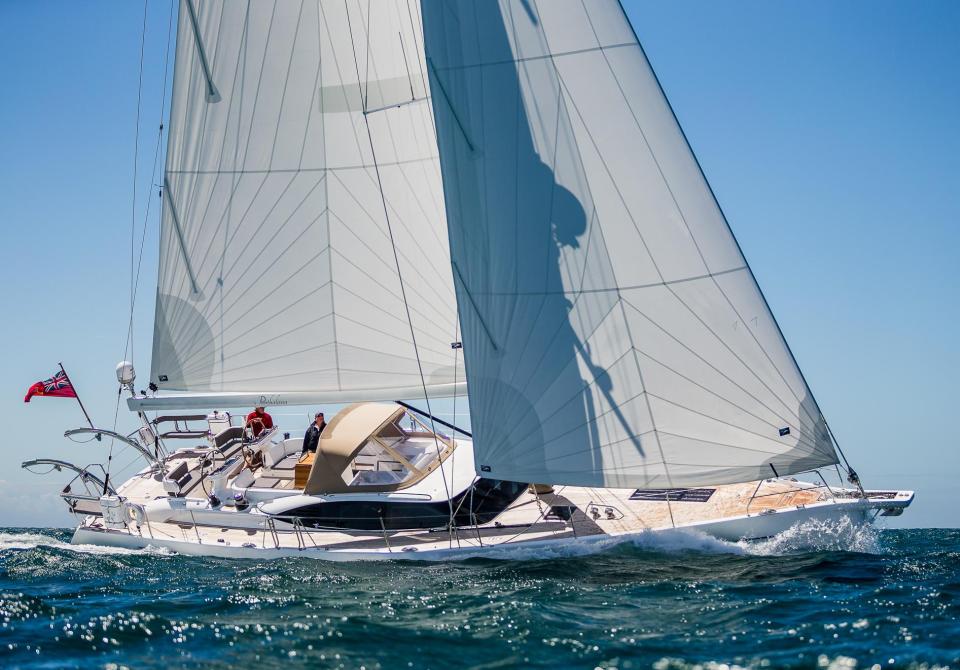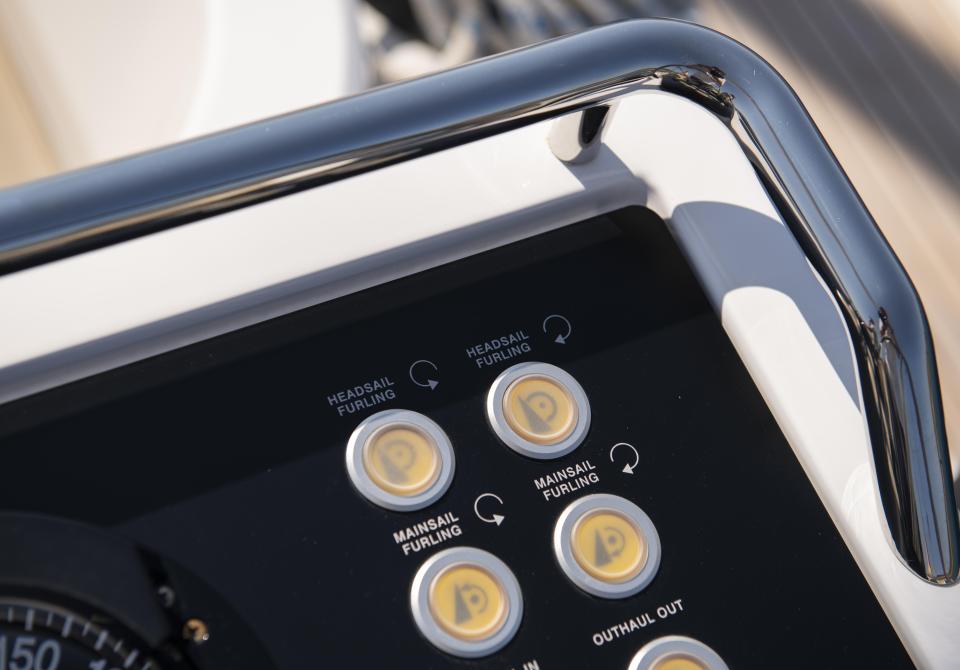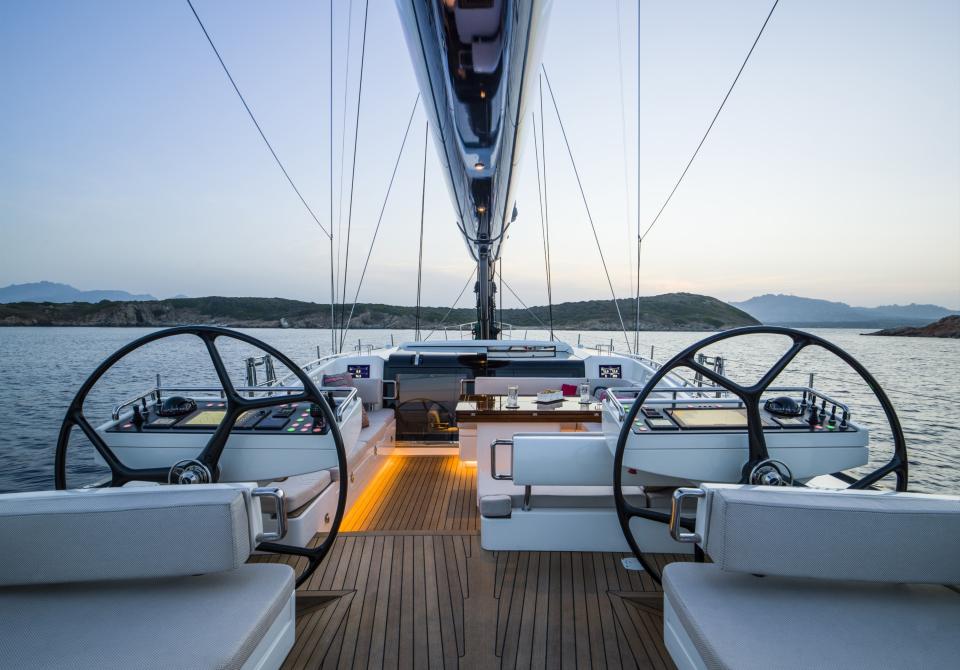If your dream is to sail across oceans or even around the world, what is the right yacht? What type and size should you look for? And what equipment is going to add most to your safety and enjoyment of life on board?
The answers to these questions will define your experience and are going to vary depending on your budget, how long you intend to be away, and with whom you’ll be sailing. There are however some common denominators you’ll need to think about to sail safely and comfortably.
First, the fundamentals of a true bluewater yacht: its design and sea-keeping attributes. A good bluewater sailboat is capable of making long passages in comfort and will look after you in whatever conditions you encounter.
Oyster Yachts are renowned for their adventuring credentials; the yachts are well-found, luxurious and solidly built. About 95 have already circumnavigated the world and with another 25 participating in the Oyster World Rally 2022-23 soon Oysters will have logged over 100 successful circumnavigations. Starting with the fundamentals, they have hulls with integrated keels, are certified for strength and safety, and have keel-stepped masts. They are designed with self-sufficiency in mind and have generous accommodation and tankage for long ranges. Equipment is over-specified, from rig and steering gear to winches and windlasses, and there is easy access to systems and machinery.
Discover the perfect yacht for ocean adventures, highlighting key design features and insights from experienced sailors. Learn how to embark on an incredible long-distance voyage.
The evolution of every design in the last 24 years is linked by a common thread: Humphreys Yacht Design. Renowned yacht designer Rob Humphreys is at the helm, working closely for the last 15 years with son Tom, a Fellow of the Royal Institute of Naval Architects.
The primary job of a bluewater yacht, says Humphreys, is to be capable of being sailed by a shorthanded crew. It has to be easily handled, comfortable at sea on long passages yet capable of a reliable turn of speed that will make the miles slip by without great effort.
“The motion of the boat is important. Performance is important, too, but less so – comfort is more telling,” Humphreys explains. He favours a hull shape with “shallower rocker forward and a deeper mid-section to distribute the volume, which creates that softer ride.”
Moderate displacement yachts such as Oysters are born passagemakers. The hull form is not only capable of producing reliable daily mileages on passage in comfort, without stressing crew or yacht, but can accommodate generous fuel and water tanks and bluewater critical items such as generator, large battery bank, washing machine and air conditioning. It also provides excellent internal stowage for stores and spares and ample locker space externally in sail locker and lazarettes.
“Control and manageability and the steering qualities are also important so there is less burden on autopilot systems. And the other side of it is that a yacht should have good load carrying abilities for stores and spares.”
The latest generation hull shapes, with plumb stems and beam carried right aft, not only look purposeful, they create a larger interior and can sail faster and more efficiently. A long waterline and greater hull volume means more accommodation in the bow area, but most particularly aft. That wider shape also benefits a yacht in pure sailing terms.
“Increased power aft helps with free stability,” Humphreys explains. “Stability is generated through hull form and is not so much dependent on the mechanical stability of the lead [on the keel]. So, in that respect, these boats are a little bit more powerful, a benefit all round, but particularly when sailing upwind and close reaching.”
Wide hull shapes are also suited to twin rudders, which in turn, says Humphreys, “gives fingertip control and makes a boat easy to steer.”
These evolutions can be traced back to race yacht design, as can the plumb bow. “That is another aspect of hull form that has translated well,” says Humphreys. “More vertical bows give you more waterline length, and that is always working for you. It gives you a better chance of sustained daily mileages, of reliable speed rather than exceptional speed.”
These latest designs also have increased freeboard, which means it is possible for yachts to have a flush foredeck for aesthetic and practical reasons, yet also really good headroom below. For Oyster Yachts it has allowed large vertical ‘seascape’ windows that let in light and connect cabins with the world and the views outside.
Other features that distinguish the true bluewater cruiser are a safe, protected and well-sheltered cockpit and helm stations, with sail controls led back; a good galley that is easy to use and secure at sea; a practical and comfortable navigation area; and clear and uncluttered sidedecks and foredeck.
The centre cockpit design that is a hallmark of Oyster Yachts is comfortable for long-distance cruise and “provides protection while sailing and entertaining in port, and is great in terms of overall visibility,” affirms owner Stephen Gratton. Stephen and his wife, Debbie, sailed around the world in their Oyster 53, Amelie, then returned through the Panama Canal to Canada and Alaska, sailed back across the Pacific to French Polynesia and are currently in Seattle.
“We have been in some extreme conditions, but even when things go wrong we know that Amelie can look after us. The comfort is great. Even in a gale, when you go below it all goes quiet. You feel like you are on a well-made boat and we like the solidity of design and thoughtfulness.”
Other attributes that mark out a capable, go-anywhere bluewater boat include a galley that is safe, secure and easy to work in. The linear galley that is a feature of Oyster yachts is designed to be a seamanlike and usable space at sea, with abundant fridge and freezer capacity, and plentiful space for food stowage.
Similarly, a secure navigation area and chart table that is comfortable, safe and inviting to use at sea is also essential, as is a powerful, reliable propulsion system, large battery banks and multiple means of power generation.
Shade and ventilation are very important for sailing in the Tropics. Oyster Yachts is the only builder to offer front saloon windows that open out to allow cooling air to circulate through the boat, and one of the few builders that still fits dorade vents for forced ventilation.
Every element is solidly built and made to last for hundreds of thousands of miles of sailing in all conditions. Above all, it the solidity of the design and strength of build that owners point to when describing what they most cherish about their yachts.
“One of the things that is very important is to be able to trust your boat under all circumstances and be well prepared for bad weather,” comments Leo Nagtegaal, another round-the-world skipper, and owner of Oyster 625 Bubbles. “Your boat is actually one of the safest places to be.
While small yachts can, and do, cross oceans, a moderate displacement, higher volume yacht has all the advantages for long-term cruising. A sweet spot for ocean cruisers lies between 45ft and 65ft. Yachts in this range can accommodate the comforts, stores and spares a crew of family and friends needs whilst also making quick passage times.
Larger yachts, fitted with hydraulic furling and electric winches, can still be sailed by a short-handed family crew, though beyond 65ft loads increase with size, maintenance demands grow too and it may require the help of professional crew.
When Leo Nagtegaal sold his business, he and his wife, Karin, bought an Oyster 56, Duchess. In 2013 they set off to realise Leo’s lifelong dream of sailing around the world.
The Nagtegaals loved the sailing life and people so much that, in 2014, they traded up to an Oyster 625. “We thought that as we’d be pretty much living aboard nine months of the year for the next five, six or seven years, we’d like just a little more space,” says Leo.
In his opinion, 45ft is the minimum size for long-term ocean voyaging: “Size is very personal,” he admits. “I have friends who went around Cape Horn in a 33ft wooden boat and did well, so they will disagree when I say that a bluewater yacht should be at least 45ft. It really depends on how the boat is equipped.”
Oysters are strong, seaworthy and reliable and when you get into bad weather you see that, you feel that.
Paul and Trish Ducker also sailed on the Oyster World Rally 2013-14 as far as New Zealand. They have ordered a new Oyster 565 and hope to take part in the 2024-25 rally. Their cruising is mainly done double-handed. “We don’t want anyone else living on board; we like the privacy and freedom,” Paul explains.
“For us, at the time about 54ft is as large as we wanted to go. Up to 60ft would be fine, but as you get older you are not so fit and strong and it tends to affect things like taking down sails and jumping around the boat coming into a marina.” On their new Oyster, they will have a bow and stern thruster to make close quarters manoeuvring easier, and headsails they can pole out for stress-free downwind passages.
Stephen and Debbie Gratton have owned six different yachts. Before buying their Oyster 53 Amelie in 2008, they owned a Contessa 32, which Stephen raced across the Atlantic in the single-handed OSTAR race. To enjoy cruising as a way of life, however, they knew they needed to change from their pretty but cramped design to a much bigger, more solidly built, heavier displacement yacht.
“Originally we thought anything over 40ft was OK for ocean passages and we thought about having a boat built for sailing round the world,” says Stephen. “But it was not going to be able to provide many creature comforts for my wife and me and we started realising that you get more comfort when a boat is over 50ft,” says Stephen.
Gratton emphasises the benefits of a bigger yacht size beyond merely space inside. “You have better ability to take the waves — the hull shape and distance between waves can all make a difference. Hull design is so important.”
Stephen Haines took delivery of his new Oyster 565, Panthalassa, in 2019. He has been planning a circumnavigation “for many, many years”. Unusually, Panthalassa represents a downsizing for Haines. He previously owned a 40m Huisman which he sailed with his young family all over the Mediterranean, the Caribbean, Bahamas and US east coast. On the Huisman, Haines had had professional crew, but for his round the world voyage he wants to skipper and run the boat himself. “Having crew on board changes the dynamics and it is not the same,” he says. “When you are employing people it takes quite a long time to make your boat a home as there a lot of people around. It can be hard work.”
Haines says the 565 is “the perfect size for me” and says: “I wouldn’t swap with a bigger boat. In terms of build quality an Oyster is right up there, strong with a good reputation. My Huisman was a one-off, but the more 565s they build, the happier I am. It is easier to get spares and it adds to the residual value.
“I bought the boat to go across oceans and for me it is about the motion of the boat. Panthalassa sits on the water like a much, much bigger boat and in a big sea I have been impressed with her seakeeping.”
what equipment do you need?
From sails to power management and electronics, a multitude of choices shape the ideal bluewater cruiser. The sail inventory, for example, is part of personalising your boat and will depend on how many crew you have and how you like to sail.
The majority of ocean crossings on a tradewinds circumnavigation are on reaching and running angles. A suitable downwind set up can be as simple as the mainsail and a poled-out genoa, or it could be twin headsails set to run day after day. Or you might want to add more power and speed with an asymmetric spinnaker on a furler, or a specialised spinnaker such as the Parasailor.
Ideally, you would have multiple off-wind sail options (including for regattas if you plan to race) and upwind sails that can easily be reefed. In-mast furling, automated systems and electric winches take all the hard work out of reducing sail.
The latest Oysters and other modern cruising designs feature bowsprits that allow an additional light wind Code Sail to be set on a furler so you can keep sailing instead of turning on the engine. But whatever you add to the inventory, the important thing is to have sails that you want to use and don’t find daunting.
High on the list of essentials is a robust windlass that can handle as large an anchor as possible, ground tackle of up to 100 or 120m for anchoring in deep bays, and a second kedge anchor. The CQR type is ever popular, though many Oyster owners opt for a Rocna or upgrade to the stainless steel Ultra anchor, says Durham.
Power management is one the biggest and most critical issues boat owners face. “Questions about power come up all the time. Power management is key, and trying to use as little as possible,” says Mark Durham. Most Oyster owners opt for a generator, but are increasingly looking at diversifying power sources with solar and hydro power also charging high capacity lithium ion batteries.
“It is about trying to use as many different methods of power generation as you can, for example wind generators, hydrogenerators or solar panels,” says Durham. Alternative energy sources not only reduce emissions and the consumption of fossil fuels, they also allow longer periods of silent running and extend generator service intervals.
“We are doing a fantastic project at the moment on Oyster 725 hull number 1, putting solar panels on the hard top so [the owner] will not have to use his generator as often,” says Mark Durham. “He has got 12 lithium-ion batteries giving 2400Ah. Previously he was using his generator in the morning and evening to charge batteries and make water, now all systems can be run off batteries that are charged by the solar panels, and the generator is run rarely.
Now, with 24v watermakers we can run them off the batteries, which can be charged by solar power.”
“This is a really interesting part of the planning and many owners are enjoying the process of using less diesel.”
Power upgrades are always a worthwhile element of a refit. Stephen Gratton says that fitting a new 5kW inverter and 400 A/h of lithium ion batteries to his Oyster 53 is “the biggest change we have made in the 13 years we have had our boat. I would say that the ability to have big gaps between charging and the silence when cooking is one of the best things.”
Leo Nagtegaal also upgraded the inverter on his Oyster 625, Bubbles, to a 5kW unit and has solar panels on his hard-top bimini. “That provides two-thirds of my power needs. I can run more equipment, for example the washing machine and other appliances, so that was a big improvement,” he says.
A watermaker is a prized item on bluewater cruisers of all sizes, giving crews independence from shore. A reliable, well-specc'ed autopilot that has a fast speed of response downwind, with back-up spares, is essential. Bow thrusters and even stern thrusters are increasingly popular, especially for couples who sail two-up frequently.
Communications is critical for almost all long-term cruisers. Satellite comms and on board Wi-Fi networks not only make it simple to keep in touch with home, friends and work but to get detailed real-time weather data and forecasts, and even repair advice and downloads. SSB radio, dated technology though it undoubtedly is, also remains popular with crews who live aboard for lengthy periods – this is still a good way to connect with the cruising community and the camaraderie and help it offers.
“We use Iridium for weather data and emergencies, but for us SSB is something we enjoy using,” says Stephen Gratton. “We came up from French Polynesia to the Pacific North West this year and were part of a [radio] net and we had our last discussion the night before we arrived in the Juan De Fuca Strait, 4,000 miles away. It really felt like people there were thinking about you.”
For getting ashore, and as a transport workhorse when at anchor, everyone needs a sturdy tender and reliable outboard that can easily be brought aboard and stowed away. Solid floor inflatables or small RIBs are the best choice, stored securely on davits, or mounted on the foredeck.
On an extended voyage, your yacht is your home, a place to entertain guests and enjoy visits from friends and family. Comforts are important and, unsurprisingly, all the cruisers we spoke to advised having as many of them as possible.
Paul and Trish Ducker have lived aboard their Oyster 54, Babe, almost full-time since she was launched in 2011. For their new boat, an Oyster 565 currently in build, they are going for “all the mod cons”.
While accepting that high equipment levels may bring increased demands in terms of maintenance, Paul says: “It is our home, so we want everything, from air-con to a water maker to a washing machine."
“I would say,” he adds, “everything generally on Oysters is useful even if is not essential.” At the top of the Duckers’ priority list are a large capacity fridge and freezer; sufficient power to run a washing machine; air conditioning from time to time; an electric cooker; and entertainment equipment.
Stephen and Debbie Gratton also mention an electric hob and cooker. "It really works for us. Food is a very important part of our enjoyment at sea and entertainment with friends. The change to lithium batteries was a game changer for us as we can use any of these appliances with just the inverter.”
Andy Armshaw is one of Oyster Yacht’s most experienced project managers, helping owners make the right choices for comfortable cruising. “Good galley set-ups are important,” he agrees. “Most people now go for a Quooker boiling water tap so there is no need to put a kettle on or a pan on the stove. More people are definitely looking at fitting an induction hob and there is a move away from gas, not only from the safety point of view but getting a refill in different places.”
Owners want “really well-appointed heads, and generally want what they have at home, such as fixed head rain showers. They also expect their boat to be comfortable, and we offer a choice of soft furnishings, fabrics and timbers. Also sprung mattresses, because one of the most valuable things on board is rest.”
Good lee cloths are needed for sea berths and are worth fitting in the saloon as well as in cabins. “Sometimes people in forward cabins will migrate aft at sea,” observes Armshaw.
A bimini that can be kept up on passage will keep crew shaded from the sun. A canvas sunshade for covering the cockpit and perhaps also the foredeck will extend your outdoor living area in the Tropics. The biminis and sprayhoods fitted to Oyster yachts are also extremely solid and to be kept up permanently while sailing.
When he was spec’ing his new Oyster 565 Panthalassa, Stephen Haines thought: “If I am going to be living on it and sailing round the world, quite honestly give me everything. I want the icemaker, nice mattresses, a washing machine, a tumble dryer. I got almost everything you can get. It’s nice to have everything – why not?
Like everyone we spoke to, Haines admits that maintenance comes with the territory. What makes the biggest difference to an owner is having excellent after sales support and advice at the end of a phone line.
“I have learned more about that in the last two years than in the rest of my life and now I’m living on the boat it has become daily life. But you only have to get Oyster Yachts on the phone, and they can talk me through it. I reckon it took nearly a full season to really get to this stage and really know my boat inside out and back to front.
“Now, I am very comfortable. I know my boat can cope with any conditions. If she could speak, I think Panthalassa would say ‘There’s nothing to worry about’.”
It is our home, so we want everything, from air-con to a water maker to a washing machine
How long does it take to prepare to cast the lines off and go cruising? Typically, owners getting ready to go off for an Atlantic crossing or further, take a season or two to prepare, though I have met many people who have successfully done it much quicker. A longer runway, however, allows you to spec your boat, trial it thoroughly, and get your life organised for leaving.
Some owners advocate a year of home waters cruising before going further afield. For example, Leo Nagtegaal had his Oyster 56 Duchess shipped to Singapore, where he was working, and sailed from there for several years until taking full retirement and joining the Oyster World Rally 2013-14. A period of shorter-range cruising allows the whole crew to gain the knowledge, training and skills needed, including essential maintenance know-how and medical and sea survival training – and to understand your boat inside out.
But however, you plan to break free, what really helps is a deadline: a date that you are going to set off, with a scene you can visualise to keep you motivated as you work through the preparations and demands of shore life. Most preparations are really just logistics, and you’re probably already pretty good at that. The bigger obstacle is often mustering the courage to leave.
Preparing a bluewater yacht and all that is needed to set free and go is a complex project, but you’ll have plenty of good help and advice along the way. I have yet to talk to anyone who has regretted it. When I ask bluewater sailors for their best advice, it usually boils down to a simple prescription: just go. Life is too short to put off your dreams.
